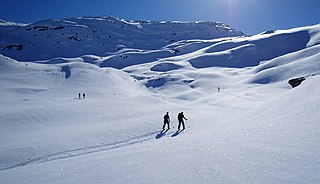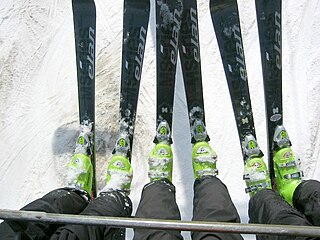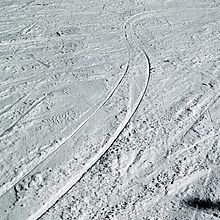
Cross-country skiing is a form of skiing whereby skiers traverse snow-covered terrain without use of ski lifts or other assistance. Cross-country skiing is widely practiced as a sport and recreational activity; however, some still use it as a means of transportation. Variants of cross-country skiing are adapted to a range of terrain which spans unimproved, sometimes mountainous terrain to groomed courses that are specifically designed for the sport.

Snowboards are boards where the user places both feet, usually secured, to the same board. The board itself is wider than most skis, with the ability to glide on snow. Snowboards widths are between 6 and 12 inches or 15 to 30 centimeters. Snowboards are differentiated from monoskis by the stance of the user. In monoskiing, the user stands with feet inline with direction of travel, whereas in snowboarding, users stand with feet transverse to the longitude of the board. Users of such equipment may be referred to as snowboarders. Commercial snowboards generally require extra equipment such as bindings and special boots which help secure both feet of a snowboarder, who generally ride in an upright position. These types of boards are commonly used by people at ski hills, mountains, backcountry, or resorts for leisure, entertainment, and competitive purposes in the activity called snowboarding.

Skiing is the use of skis to glide on snow. Variations of purpose include basic transport, a recreational activity, or a competitive winter sport. Many types of competitive skiing events are recognized by the International Olympic Committee (IOC), and the International Ski and Snowboard Federation (FIS).
A ski is a narrow strip of semi-rigid material worn underfoot to glide over snow. Substantially longer than they are wide, and characteristically employed in pairs, skis are attached to ski boots with ski bindings, with either a free, lockable, or partially secured heel. For climbing slopes, ski skins can be attached at the base of the ski.

Snowboarding is a recreational and competitive activity that involves descending a snow-covered surface while standing on a snowboard that is almost always attached to a rider's feet. It features in the Winter Olympic Games and Winter Paralympic Games.

Alpine skiing, or downhill skiing, is the pastime of sliding down snow-covered slopes on skis with fixed-heel bindings, unlike other types of skiing, which use skis with free-heel bindings. Whether for recreation or for sport, it is typically practiced at ski resorts, which provide such services as ski lifts, artificial snow making, snow grooming, restaurants, and ski patrol.

A dry ski slope or artificial ski slope is a ski slope that mimics the attributes of snow using materials that are stable at room temperature, to enable people to ski, snowboard or snow tube in places where natural, snow-covered slopes are inconvenient or unavailable.

The snowplough turn,snowplow turn, or wedge turn is a downhill skiing braking and turning technique. It is the first turn taught to beginners, but still is useful to advanced skiers on steep slopes.

The stem christie or wedge christie, is a type of skiing turn that originated in the mid-1800s in Norway and lasted until the late 1960s. It comprises three steps: 1) forming a wedge by rotating the tail of one ski outwards at an angle to the direction of movement, initiating a change in direction opposite to the stemmed ski, 2) bringing the other ski parallel to the wedged ski, and 3) completing the turn with both skis parallel as they carve an arc, sliding sideways together.
The parallel turn in alpine skiing is a method for turning which rolls the ski onto one edge, allowing it to bend into an arc. Thus bent, the ski follows the turn without sliding. It contrasts with earlier techniques such as the stem Christie, which slides the ski outward from the body ("stemming") to generate sideways force. Parallel turns generate much less friction and are more efficient both in maintaining speed and minimizing skier effort.

Giant slalom (GS) is an alpine skiing and alpine snowboarding competitive discipline. It involves racing between sets of poles ("gates") spaced at a greater distance from each other than in slalom but less than in Super-G.
The Arlberg technique is a progressive system that takes the skier from the snowplough turn to the parallel christie through measured stages of improvement. The system, or slightly modified versions, remains in widespread use to this day. Modern ski equipment is also capable of a more efficient turning style known as carving that uses entirely different techniques and movements. Some ski schools have started moving students directly from the snowplough to carving as early as possible, avoiding learning stemming habits that may be difficult to un-learn.
Elan is a Slovenian company, located in Begunje na Gorenjskem, specializing in the production of sporting goods. It is best known for its skis and snowboards. Other products include sailboats from 30 to 50 ft length, motor yachts, apparel, and equipment for sports facilities. The brand became better known in the late 1970s, when Swedish alpine skiing ace Ingemar Stenmark won three consecutive World Cup overall titles on Elan skis. The company also manufactured license-built DG gliders from 1978.

Ski geometry is the shape of the ski. Described in the direction of travel, the front of the ski, typically pointed or rounded, is the tip, the middle is the waist and the rear is the tail. Skis have four aspects that define their basic performance: length, width, sidecut and camber. Skis also differ in more minor ways to address certain niche roles. For instance, skis for moguls are much softer to absorb shocks from the quick and sharp turns of the moguls and skis for powder are much wider to provide more "float" in deeper, softer snow.

Mogul skiing is a freestyle skiing competition consisting of one timed run of free skiing on a steep, heavily moguled course, stressing technical turns, aerial maneuvers and speed. Internationally, the sport is contested at the FIS Freestyle World Ski Championships, and at the Winter Olympic Games.

Developed during the winter of 1996 by Martin and Erik Fey, the Teleboard consists of a long, narrow snowboard, or wide ski, with two free-heel telemark bindings arranged one in front of the other at a slight angle to the longitudinal axis. This is similar to a skwal which uses fixed-heel bindings mounted in line with each other.
The Dual Edge Snowboard (DES) is a technical categorization of a general snowboard concept and technology, where a device or mechanism creates two simultaneously ridden edges for a snowsport equipment that allows the user to ride in a similar fashion to the basic (classic) snowboard.

Line Skis, commonly shortened to Line or stylized as LINE, is a new school skis company owned by K2 Sports. Line Skis was founded by Jason Levinthal in 1995 to produce short, twin-tipped skis for freestyle skiers, and has since moved to produce full-length freeskis.

The SCX, for "SideCut eXtreme", was an alpine ski introduced by Elan in the winter of 1993/4. Skis before the SCX had almost always used a shape that was slightly curved inward on the sides, typically by 7 millimetres (0.28 in) compared to a straight line running from tip to tail. The SCX was designed with over 22 millimetres (0.87 in) "sidecut", producing a wasp-waisted ski unlike anything on the market.
This glossary of skiing and snowboarding terms is a list of definitions of terms and jargon used in skiing, snowboarding, and related winter sports.
















